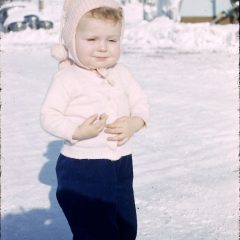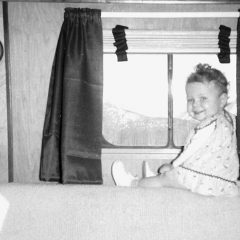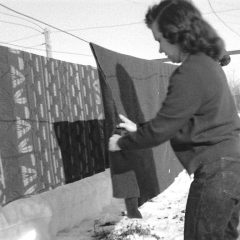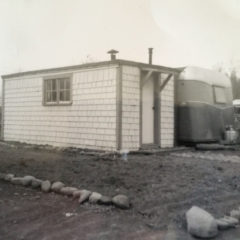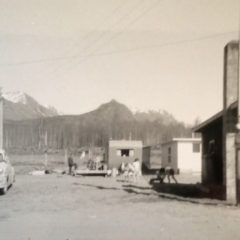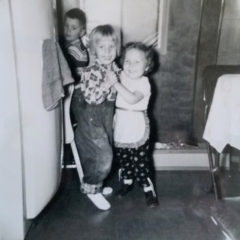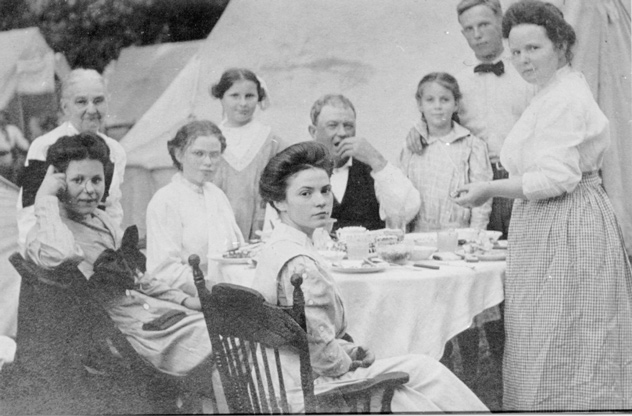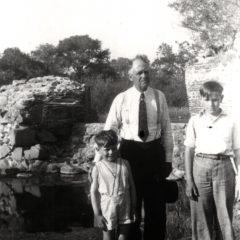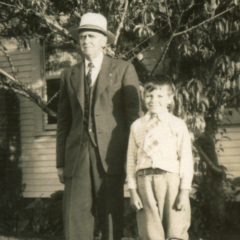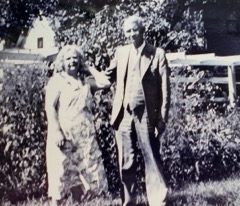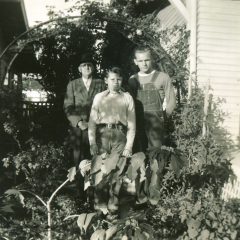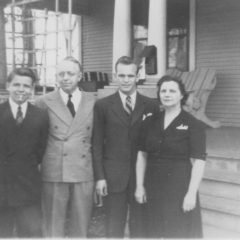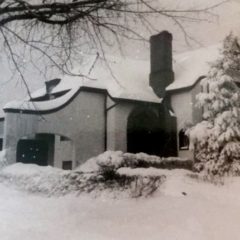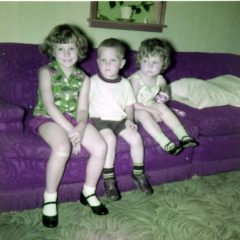Back To: Nebraska in 1918
James Bela and Jennie Liggett’s son, George Harlan “Hal” Liggett graduated from San Diego High School in 1917 and went into the military for World War I. After the war he went back to Lincoln to attend the University of Nebraska. He graduated with a Bachelor of Agriculture degree in 1921. While in college, he met and married Grace Hawley Guinn (the only child of Henry Thomas Guinn and Sarah E. Hawley, born March 19, 1899 in Nebraska City) in 1919.
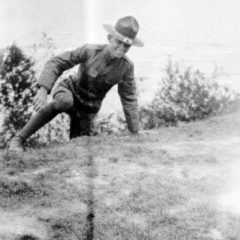

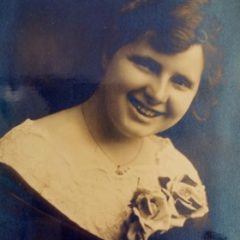
Bartlett Guinn came to America from Antrim, Ireland, marrying Katherine Fambrough in Virginia in the 1750s. Grace’s maternal grandparents and great grandparents, the Hawleys and Irwins, were from Ireland and prominent among the early settlers in Nebraska City. Morton’s History of Nebraska includes an entry about Grace’s grandfather:
Robert E. Hawley, the proprietor of the Hawley Ice Company and manager of Otoe Preserving Company, Nebraska City, Nebraska was born there in 1864. His father, Martin J. Hawley, and his maternal grandfather, John Irwin, were prominent among the early settlers in Nebraska City (home of Arbor Day). Martin was born in County Sligo, Ireland, his father being an official in the British Army, and his mother in Maidenhead was Grace Lyons. When Martin was six years old his father died leaving six children, and he was brought to New York City by an uncle, Reverend McDonald, a priest in the Roman Catholic Church, who sent him to William and Mary College. (He was to be educated as a priest but had too roving a foot). One sister, Ellen, also immigrated to the United States, and married William Wright of Scranton, PA. Martin Hawley in 1849 went to the gold fields of CA. Returning across the plains; he found employment in the Indian Agency in Council Bluffs, Iowa. In 1856, he settled in Nebraska City, and during the remainder of his active career he conducted a mercantile business there. He identified himself actively with the planning of the Catholic Church at Kearney Heights and contributed his money and labors in building St. Benedict’s and the first St. Mary’s Catholic Churches. He was married at Nebraska City to Miss Elizabeth Irwin, daughter of John Irwin, who settled there in 1856.
Elizabeth Irwin Hawley standing left; granddaughter, Grace Guinn, standing to her left; daughter, Sarah (Sadie) Hawley Guinn standing on right side of picture.
John Irwin was the son of James Irwin, who with his brother James Jr. settled at Moylan, PA, a suburb of Philadelphia, about 1818. There James engaged in the Lehigh Valley coal industry. At Philadelphia John Irwin married Miss Esther Bell, a native of County Monaghan, Ireland, and with his wife removed to Zanesville, Ohio. From there he removed his family to Nebraska City in 1857. At Nebraska City he conducted a general store and invested in about 10,000 acres. He owned the site of the capital in Lincoln and the site of Fort Omaha (he would not pay the taxes and lost all of it and that is why we in the present day do not have any).
John Irwin was a member of the Presbyterian Church and died in October 1893 when he was 94. Elizabeth B. Irwin Hawley resided in Lincoln, NE. Her three daughters are: Anne Brandhover, deceased, of York, Nebraska; Ida, wife of Ed. D. Marnell, of Nebraska City News, and Sadie, wife of Henry Thomas Guinn of Lincoln, NE.
Robert E. Hawley was for thirteen years a conductor and roadmaster on the Southern Division of the Burlington and Missouri Railroad. He married Miss Crene or Lorene Johnson, daughter of Magnus Theodore and Charlotte Waterfall Johnson, the latter born in Hampshire, England, August 11, 1837 and came to America with her parents who settled at Cleveland, Ohio, where her father engaged in the watch and jewelry business. She married Magnus Theodore Johnson at Nebraska City in November, 1857, and was the mother of six children: James Fred Johnson, assistant chief of the railway mail service at Kansas City, Richard Henry Johnson, railway postal clerk, Nebraska City, Crene now the wife of Robert E. Hawley, Nebraska City, J. Charles Johnson, deputy county treasurer, Nebraska City, Mones E. Johnson, clerk in the post office in Nebraska City, and Nellie Johnson, teller of the Stock Yards Bank of Saint Joseph, Missouri.
Magnus Johnson removed to Nebraska City April 25, 1856. He was born in Kristianstad, Sweden, August 21, 1829, and finished his education at the high schools in Berlin, Germany. At the age of 22 a Scandinavian colony requested him to accompany them to America as their interpreter. After making nine trips and landing at Quebec, he proceeded to Chicago and other parts of Illinois, and decided to remain in this country. He operated a clothing store at Monmouth, Ill., until 1856, and that year removed to Nebraska City. Mr. and Mrs. Robert E. Hawley have a family of three sons and one daughter. (Grandfather Johnson told mother he had been an interpreter on a Swedish ship and had made nine trips over and then decided to jump ship and stay in this trip. According to the story he and Grandmother met when the boat grandmother was coming up the Missouri from St. Louis was wrecked on a sandbar, which was a common occurrence, and the passengers transferred to the boat Grandfather was on.
“Sadie’s family left the Catholic Church over birth control. Grace’s cousin, Robert Monas, was prisoner of war in W.W.II and taught school to fellow prisoners. His uncle had died in W.W.I.” Was it Sarah Hawley that went to the 1893 Chicago World’s Fair and brought home a set of books called The Art of the World?
George Harlan Liggett’s first job out of college was in Gurley, Nebraska, teaching manual arts in 1920. He and his wife, Grace, then moved to Sundance, Wyoming, where they taught school. Harlan was the Supt. of Sundance High School in 1925 and also coached basketball there. They moved from there to Union, Nebraska, where they farmed 80 acres owned by Grace’s father, Henry Guinn.
Their first son, George Harlan Liggett II, was born in Lincoln on August 15, 1923. In 1927 they moved back to Lincoln. They lived at 1515 N. 32nd St. and /or 3071 N St. while Harlan worked as an Associate Social Science Analyst and attended the University of Nebraska to earn his Master of Science degree, specializing in Poultry Husbandry. His thesis analyzed the effect of various methods of housing poultry on hatching power of eggs produced. His study concluded “more favorable hatchability from birds housed in the unheated houses … Laying hens can adapt themselves quite well to rather wide ranges of temperature, ventilation and humidity without any marked disturbance of fertility and hatching power.” Did Hal have an interest in poultry since posing with this bird as a young man? He seems to be happier sitting with the dog, though.
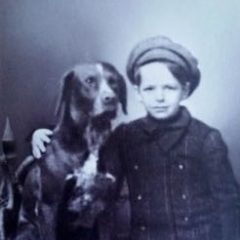
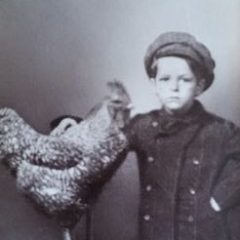
He graduated in 1928 and decided to postpone continuing for a doctorate to get more involved in farming. He managed his father’s Nebraska farms while Grace taught at a local elementary school. George Harlan Jr. went to school with his mom, skipping kindergarten. He recalls that his mother didn’t work after his brother; James Guinn (Jim, my father) was born on June 25, 1929, in Omaha when his dad was teaching at South High. “After income came in from managing J.B.’s farms, things were better off economically. They had a hired girl to help out.”
During the Depression, the family moved on to Hoisington, Kansas and then to Seward while Harlan Liggett was a poultryman for the Missouri Pacific Railway and wrote the “Poultry Column” for the Utica Sun. His efforts to get additional income for his family included an attempt to get into the car selling business, which was discouraged by his father, JB Liggett.
Unable to find sufficient income, Harlan decided to move the family west to San Diego and sold all of their furniture. But at the last minute, he got a job in Wayne as a county agent. The kids stayed in an apartment in Lincoln near 29th and O, temporarily, until moving to Wayne where Jim started school. They would listen to their Dad give farm reports on the radio on the train ride to Wayne. The Wayne Herald reported their car trip to San Diego June 6, 1935.
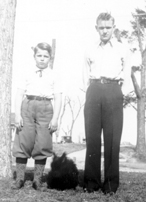 In December 1936, they all moved back to Lincoln to live at the Guinn house after Grace’s mother, Sarah Hawley Guinn and her sister, Ida, were hit and killed by a milk truck while wintering in Brownsville, Texas. She was 62. Her husband,Henry Guinn, was a railway passenger agent for the Missouri Pacific Railroad and could use it for free travel. The sisters were walking the dog in the evening and got confused when they saw the truck, stepping into it instead of away. Henry then left the house he built in 1908 at 371 “N” Street to live with his sister on Magnolia Blvd. in Riverside, CA.
In December 1936, they all moved back to Lincoln to live at the Guinn house after Grace’s mother, Sarah Hawley Guinn and her sister, Ida, were hit and killed by a milk truck while wintering in Brownsville, Texas. She was 62. Her husband,Henry Guinn, was a railway passenger agent for the Missouri Pacific Railroad and could use it for free travel. The sisters were walking the dog in the evening and got confused when they saw the truck, stepping into it instead of away. Henry then left the house he built in 1908 at 371 “N” Street to live with his sister on Magnolia Blvd. in Riverside, CA.
Harlan and Grace Guinn Liggett lived in the house with their two sons, George Harlan Jr. and James Guinn (pictured above in 1939 with their dog), for ten years, the longest time they would live in one place. They drove to California several times to see Grandfather Henry. He died there in 1941 and was brought back for burial in Nebraska City next to his wife, Sarah (both are pictured below).
In 1940, George Harlan Liggett Sr. got a job with the Farm Security Administration as a Regional Program Analyst and worked there until President Truman reorganized it in 1947.
He also set up his own farm management business, Midwest Farm Service, in Lincoln and taught veterans at night west of York.
The family moved into their own house on No. 40th Street in 1946.
After the Farm Security job ended, Harlan went to Omaha to work as a research statistician for the Missouri River Basin Section of the National Park Service for two years. Harlan and Grace divorced in 1949 after being married 30 years.
Harlan married Esther Pauline Herrmann on Sept. 14, 1950. A year later he was working as an Economist for the Office of Price Stabilization in Omaha. In this position he received a commendation from the National Director for a study publication on income distribution between agriculture, labor, and capital between 1920 and 1950.
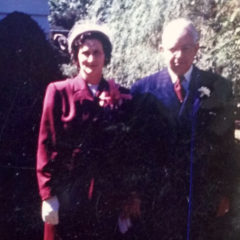
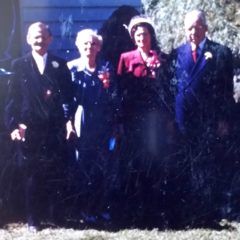
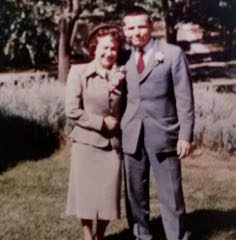
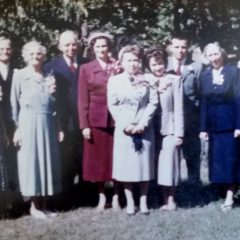
The study emphasized the effects of price stabilization on these segments during WWII. Harlan and Esther then moved to San Diego and lived at a 1219 24th St. He was working for San Diego County Public Works Department when he passed away on March 21, 1957. He left the Nebraska farms that had been passed to him by his father, James Bela Liggett, to his two sons, George and James, and was buried at Glen Abbey Memorial Park in San Diego. Grace remarried twice and also moved to California. She had a variety store business in Los Angeles with her third husband, Horace Gray. Later she taught elementary school in Northern California where she passed away January 9, 1969.
Harlan’s oldest son, George Harlan Liggett II, served in the U.S. Army Artillery during World War II. He was sent to California, initially to Camp Roberts, and then on to Stanford University where he completed pre-med classes. From there he was transferred to Madison, Wisconsin where he provided dental services to the military. At the end of the war, he applied and was accepted to the dental school at the University of Nebraska. George married Ione from Exeter, NE, on Sept. 12, 1946, in Lincoln. After earning his doctorate in 1948, they moved to Beatrice to join the practice of Dr. Beckman. In 1949, they moved to Exeter, where they lived when their two children were born at the hospital in York: Martha in 1950 and George Harlan Liggett III three years later. “Doc” was called back to military service during the Korean War. After going to “boot camp” in Alabama, Captain Liggett and his family went to his assigned base in Topeka, Kansas. When his service ended in 1955, he bought out an existing dental practice in York and moved the family back home to Nebraska.
Martha and George III also graduated from the University of Nebraska. Martha earned her undergraduate Dental Hygiene degree and George graduated with a BA in Psychology. Like many Liggetts before him, George made his way to the West Coast where he completed his MBA at the University of Southern California. Specializing in the health care industry, he earned a second Masters Degree in Health Science at John Hopkins University and is now working for a health maintenance organization in California. Martha headed east to earn at a Master’s Degree at Columbia University in Dental Hygiene Education and a Juris Doctorate at Georgetown University. Working as an executive director of a medical professional society, she and her husband, Jim Bader, and son, Nicholas, live in Maryland. George II retired from his dental practice in 1997. He has served his community as President of the Knights of Columbus, Exalted Ruler of the Elks, and as a long time and active member of the Sertoma (Service to Mankind) Community Club.
Harlan’s second son, James (Jim) Guinn Liggett, met Rose Zella Eitel (my mother, fifth and youngest child of Lowella and John Eitel, born Oct. 21, 1930 in Lincoln) while at Northeast High School in Lincoln (pictured right).
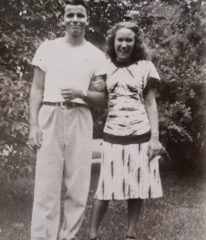
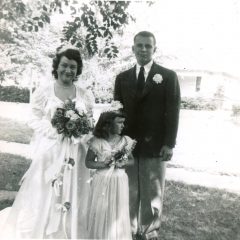
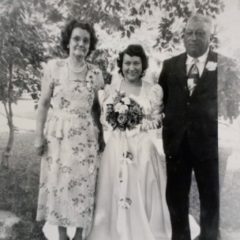
They married on August 13, 1949, at St. Matthews Episcopal Church. Jim was 20 and attending the University of Nebraska. After graduation, he joined the Air Force. Jim and Rose Liggett moved from Lincoln, NE to Henry Street in Brooklyn, New York, for Jim’s dental technician training. Their first child, Jacqueline, was born there in 1952.
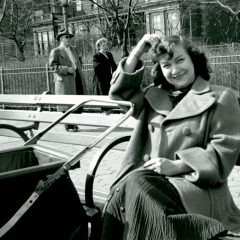
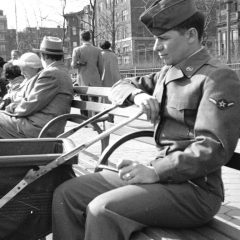
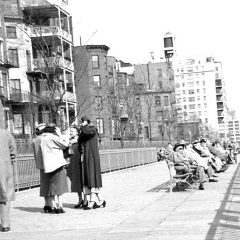
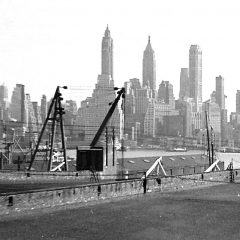

Liggett family reunion back in Nebraska in 1952: left to right: Rose, Esther holding Jacquie (me) and Martha, and Ione. Jim, Jacquie, George Harlan, Martha, and George Harlan II.
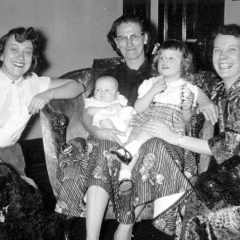
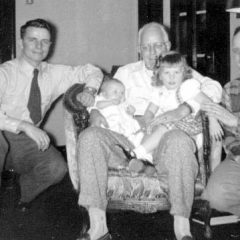
The following year, 1953, when I was less than a year old, my parents and I flew across the country to the Territory of Alaska where my dad worked at the US Air Force 5005th Hospital Group – Elmendorf Air Force Base. With housing scarce in post WWII Anchorage, my parents rented a 26×6 ft. one-room trailer at the Lazy Mountain Trailer Court at Mile 14 on the Glenn Highway in Eagle River on the 160-acre Tedrow Homestead. Ray and Lucy Tedrow were among the original homesteaders of Eagle River, coming from California in 1949. My sister, Teresa Ann, was born at Elmendorf Air Force base October 26, 1955, the same year the Tedrows started building the Eagle River Shopping Center along the Glenn Highway (in front of their trailer court) to serve the approximate 3000 families living in the area.

